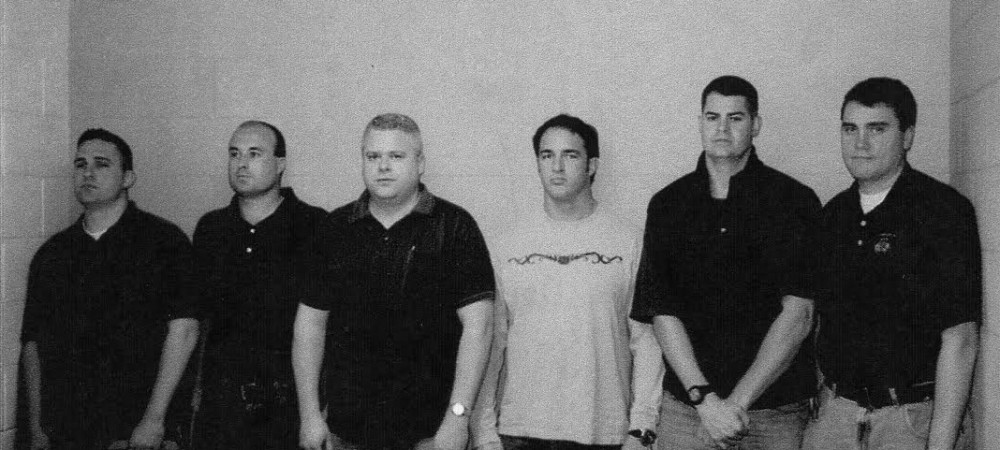
Richard J. "R.J." Vanecko (second from left) with Chicago Police officers in a May 20, 2004, lineup in the David Koschman case. | Chicago Police photo
CPD phasing out lineups
Published May 5, 2014
By CHRIS FUSCO AND TIM NOVAK
Staff Reporters
The Chicago Police Department is cutting back on its use of lineups, the crime-fighting tool that allowed a nephew of former Mayor Richard M. Daley to avoid criminal charges for years in the death of David Koschman.
Since witnesses couldn’t identify Daley nephew Richard J. “R.J.” Vanecko in a police lineup 10 years ago, police and prosecutors wouldn’t file charges.
Even without the witness identification, though, special prosecutor Dan K. Webb got a grand jury to indict Vanecko, who pleaded guilty Jan. 31 to involuntary manslaughter, admitting he threw a punch that killed Koschman. Vanecko served 60 days in jail.
Now, the Chicago Police Department is moving to “reduce the department’s reliance on physical lineups,” saying the move will save time and money.
The shift began in the Area South detective division last fall and has since been expanded to include Area Central — two of the department’s three detective divisions.
“Barring any issues, it will be expanded to Area North in the coming months and effectively become CPD policy,” police spokesman Adam Collins says.
Though the pilot program began Nov. 6 — nearly a year after Vanecko’s December 2012 indictment — the police department says his case had nothing to do with the decision to move away from lineups.
And Webb says he had no role in the decision, though his report on the Koschman case questioned why the police needed a lineup.
Webb made his case by connecting the dots: Witnesses said Koschman was punched by the biggest guy among two groups involved in a drunken, late-night confrontation in April 2004 on Division Street near Dearborn. At 6-foot-3, 230 pounds, Vanecko was the biggest guy.
Until it began moving away from lineups, Chicago’s department had been the largest police force in the United States still relying on them, according to the department’s research. Other big-city departments — including New York and Los Angeles — instead ask witnesses to identify crime suspects by viewing photos.
Lineups are time-consuming and expensive. In Chicago, evidence technicians had been getting more than 2,200 requests a year to photograph lineups.
It typically takes detectives four hours to set up and conduct each lineup. And that doesn’t include the time it takes to bring in “fillers” — police officers, people in jail or volunteers to stand in the lineup with the suspect.
Under the pilot program, witnesses view several photos. If they identify a suspect, detectives still have the discretion to also hold a lineup.
The Cook County state’s attorney’s office — which had often refused to charge suspects who weren’t identified in a lineup, according to police interviewed by Webb’s investigators — is cooperating with the new program.
“Area South has conducted five physical lineups since the pilot program began and has conducted roughly 50 photo arrays,” Collins says. “There was only one case where there was disagreement between the area and the state’s attorney’s office.”
But Sally Daly, spokeswoman for State’s Attorney Anita Alvarez, says lineups are still “a stronger method of identification.”
The April 25, 2004, confrontation between groups including Vanecko and Koschman ended with Daley’s nephew punching the much smaller man in the face, then taking off in a cab. Hours later, detectives stopped investigating. They didn’t resume until after Koschman’s death 11 days later.
A bystander, Phillip Kohler, told Webb’s investigators detectives showed him “two or three grainy, black-and-white street-camera photographs of a white male wearing a hat.”
No other witnesses remembered being shown those photos. But one witness — Koschman’s friend Shaun Hageline — recalled that the man who hit Koschman was wearing a hat.
On May 20, 2004 — 25 days after the punch — detectives brought in Kohler, who later told Webb he was shown “what might have been the same photographs he was shown previously. . . . Kohler noted he did not recognize the person in the photographs.”
The same day, Kohler, Hageline and four other witnesses viewed a lineup that included Vanecko, who looked small alongside five Chicago cops, each of them taller or heavier than he was.
Nobody in the Vanecko lineup wore a hat. And none of the witnesses identified Vanecko.
The lead detective, Ronald E. Yawger, “did not think a hat would make any difference, as he was sure Vanecko would be identified by the witnesses,” according to Webb’s report.
Since detectives already had concluded, based on witnesses’ statements, that Vanecko punched Koschman, Webb questioned why a lineup was held.
Three since-retired police officials — Supt. Phil Cline, Deputy Supt. Steven Peterson and Cmdr. Michael Chasen — told Webb’s investigators they needed a witness to identify Vanecko to charge him.
Since no one did, the case was “nowhere near chargeable,” Darren O’Brien, the assistant state’s attorney who declined to charge Vanecko in 2004, told Webb.
O’Brien spoke to Webb’s investigators under a limited form of immunity from prosecution. He later appeared before the grand jury, testifying that he didn’t trust two Vanecko friends — Kevin McCarthy and Craig Denham — who said they didn’t hit Koschman.
“When O’Brien was reminded . . . that witnesses had stated that the person who struck Koschman was the ‘tallest’ or ‘largest’ in the group . . . O’Brien speculated that because the incident occurred in April, the Vanecko group was likely wearing jackets the night of the incident, ‘which could possibly distort someone’s impression of size.’ ”
O’Brien also testified that he threw away his files on the Koschman case. He recently retired from the state’s attorney’s office.


